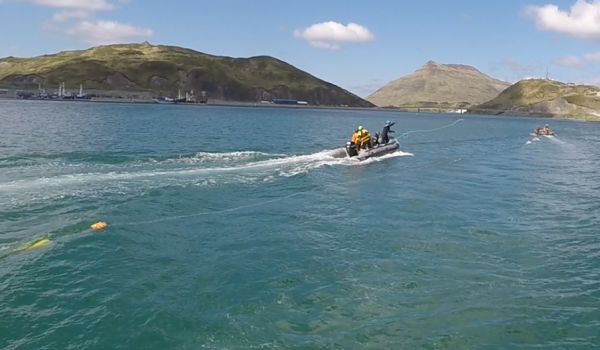Training may help save entangled whales
June 20, 2017
Paula Dobbyn
907-274-9698

A mid-June training session in Unalaska offered instruction on how to report large whale entanglements, what to look for and, most importantly, what not to do in these high-risk situations.
The intended audience included fishermen, professional mariners, biologists and law enforcement officers, said Ed Lyman, a large whale entanglement response coordinator with the National Oceanic and Atmospheric Administration in Hawaii. Lyman led the training.
Alaska Sea Grant and NOAA Fisheries hosted the Unalaska event June 12-13.
According to the International Whaling Commission, the number of whale entanglements is growing worldwide. While the problem is hard to assess because many instances go unreported, a recent IWC study estimated that 308,000 whales and dolphins die annually due to entanglement in fishing gear. The animals may starve or drown after becoming restricted by gear, suffering physical trauma and infections, or being hit by vessels, according to NOAA Fisheries.
This first-responder training in Unalaska included classroom instruction on case assessment, whale behavior, communication protocols, authorization and safety. A small group of potential responders practiced on-water techniques to remove life-threatening fishing gear or debris entangling a whale if authorized to do so through NOAA Fisheries.
Between 2000 and 2012, about 10 large whales were found entangled in waters off of Washington, Oregon and California, according to NOAA Fisheries. In 2016, a total of 71 whales were reported entangled in these waters, topping records set in 2014 and 2015. Records have been kept since 1982.

In Alaska, NOAA Fisheries has received more than 130 confirmed reports of entangled large whales since 1998, according to the agency’s website. The number of animals entangled is likely much greater since many entanglements go unreported. Fishing pots and gillnets pose the greatest entanglement threats for whales.
The agency has mounted more than 80 responses to entangled large whales in Alaska since 1998 and has freed or partially freed more than 40 animals. Last year, 17 humpbacks were reported entangled, according to NOAA Fisheries' Alaska Stranding Program.
Humpback whales are the most commonly reported entangled marine mammal species on the West Coast of the United States. The whales, with a population of 6,000–8,000 in the North Pacific, are common in the Bering Sea and Aleutian Islands where they migrate from temperate low-latitude breeding grounds to high-latitude feeding grounds each summer. Unalaska has seen a lot of whale activity in recent years, with many pods passing through Unalaska Bay and several entanglements.

During fall 2015, Unalaska had the first of three entangled humpbacks in a two-year period. During one incident, responders were unable to free a humpback tangled in commercial pot-fishing gear. The whale later died during a storm before a team of statewide responders could arrive. With increases in local fishing activity and a growing humpback population, fishery interactions with whales could increase, said Alaska Sea Grant’s Melissa Good, a Marine Advisory agent stationed in Unalaska.
NOAA Fisheries authorizes responses on a case-by-case basis under a national marine mammal permit, given the risks involved to both humans and whales in response activities. Many whales escape, so intervention is not required in many cases. Response centers on life-threatening entanglements with low-risk and viable intervention methods. A core group of people familiar with appropriate techniques, safety, boat handling and whale behavior is essential for quick and efficient response.
“It would be nice to have a few more responders in Unalaska,” Good said before the workshop.
Alaska Sea Grant is a statewide marine research, education, and outreach program, and is a partnership between the University of Alaska Fairbanks and the National Oceanic and Atmospheric Administration. Alaska Sea Grant Marine Advisory Program agents provide assistance that helps Alaskans wisely use, conserve, and enjoy marine and coastal resources.


